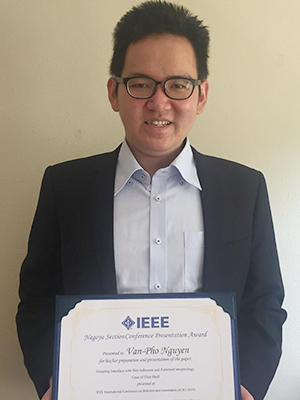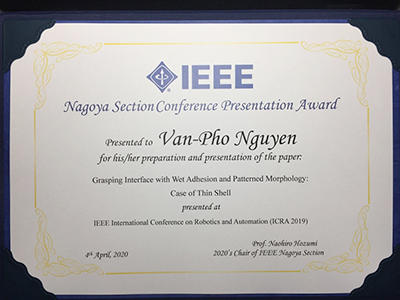Mr. NGUYEN received 2020 IEEE Nagoya Chapter International Conference Research Presentation Awards
Mr. NGUYEN, Van pho (3rd year doctoral student in HO lab of Intelligent Robotics Area) received 2020 IEEE Nagoya Chapter International Conference Research Presentation Awards.
The Institute of Electrical and Electronics Engineers (IEEE) is the largest engineering society in the world, headquartered in the United States, and currently has more than 400,000 members in more than 160 countries. The IEEE has about 300 branches, one of which is the Nagoya Nagoya branch, which is composed of IEEE members residing in the Tokai area (Aichi, Gifu, Mie, Shizuoka) and the Hokuriku area (Fukui, Ishikawa, Toyama). There are about 1,400 members.
The IEEE Nagoya Branch awards the International Conference Research Presentation Award to university students (including majors) and graduate students who present at international conferences held by the IEEE from April 1, 2019 to March 31, 2020.
■Date Awarded
April 4,2020
■Title
Grasping Interface With Wet Adhesion and Patterned Morphology: Case of Thin Shell
■Authors
Pho Van Nguyen and Van Anh Ho
■Abstract
In this letter, we present an analytical method for studying the role of the micropatterned morphology of soft fingers with wet adhesion in grasping a deformable thin shell. This letter originated from a project on a robotic platform for autonomous attachment and removal of a soft contact lens in a "human eye" under a wet environment. In this scenario, a contact lens (hemispherical thin shell) was gripped by a soft-fingered hand in three conditions: inside/outside a liquid environment and when the contact lens was in contact with a convex curved substrate (as an eye). Two fingertip surfaces were compared: a flat surface, and a micropatterned surface inspired by the adhesion mechanism of a tree-frog's toes. The pattern of the latter comprised 3600 square cells, each of size 85 μm × 85 μm interspaced by 15 μm. A proposed analytical model was utilized to evaluate the grasp forces in both types of fingertip surface. The forces were subsequently verified by application in grasping a contact lens. The experimental results showed good agreement with the analysis as the micropattern pad decreased the preload and deformation of the shell 1.1÷2 times lower than that of the flat surface. This letter could be extended to model grasping interfaces with deformable curvature objects in wet and high moisture content environments.
■Comment
I am very honored to receive the International Conference Research Presentation Awards of the IEEE Nagoya Chapter. I would like to give my deep acknowledment to my supervisor: Assoc. Prof. Ho Anh Van and my colleagues for their valuable comments and supports. Finally, I would like to thank my wife and family for supporting and encouraging me all the time.


April 22,2020
